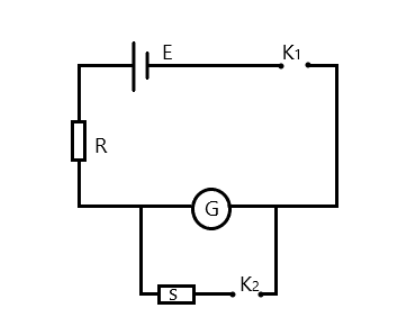Question
Question: In an experiment to determine the resistance of a galvanometer by half deflection method, the circui...
In an experiment to determine the resistance of a galvanometer by half deflection method, the circuit shown is used. In one set of readings, if R=10Ω and S=4Ω, then the resistance of the galvanometer is:

(A) 320Ω
(B) 340Ω
(C) 350Ω
(D) 370Ω
Solution
In half deflection method, the value of the resistance across the resistor is such that the deflection made will be half that of the current when the resistance was disconnected. The current is directly proportional to the deflection of a galvanometer pointer.
Formula used: In this solution we will be using the following formulae;
G=R−SRS where G is the resistance of the galvanometer, R is the resistance in the main circuit and S is the resistance across the galvanometer
Complete step by step solution:
Generally, the formula using half deflection method the resistance of a galvanometer is given as
G=R−SRS where G is the resistance of the galvanometer, R is the resistance in the main circuit and S is the resistance across the galvanometer
Hence, by inserting known values, we have
G=10−410(4)=640Ω
⇒G=320Ω
Hence, the correct option is A
Note: For clarity, the formula used can be proven as follows:
First, let’s assume the key K1 is the only closed key. In this case the current flowing through the circuit, and hence through G will be
IG=R+GE
Generally, the deflection shown in the galvanometer is proportional to the current flowing through it. Hence,
IG=kθ
Then
S+GSI=2kθ
Now, assuming we close the key K2, it can be proven that the current flowing through the galvanometer becomes
IG′=S+GSIwhereI is the new current flowing through the main circuit, hence the current flowing through R.
In the half deflection method, the value of S is adjusted such that the deflection is half of the original value when the key K2 was not closed.
Thus,
IG′=2kθ.
⇒S+GSI=2kθ
Dividing equation above by S+GSI=2kθ, and simplifying, we have
E(S+G)SI(R+G)=21
Now, the equivalent resistance of the circuit is
Req=R+S+GSG. Then the current would be
I=ReqE=R+S+GSGE
Then substituting into E(S+G)SI(R+G)=21 and then simplifying to make G subject, we have
G=R−SRS
